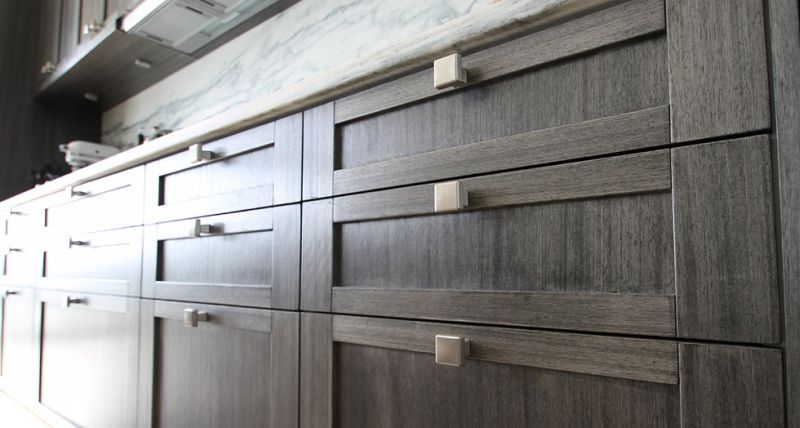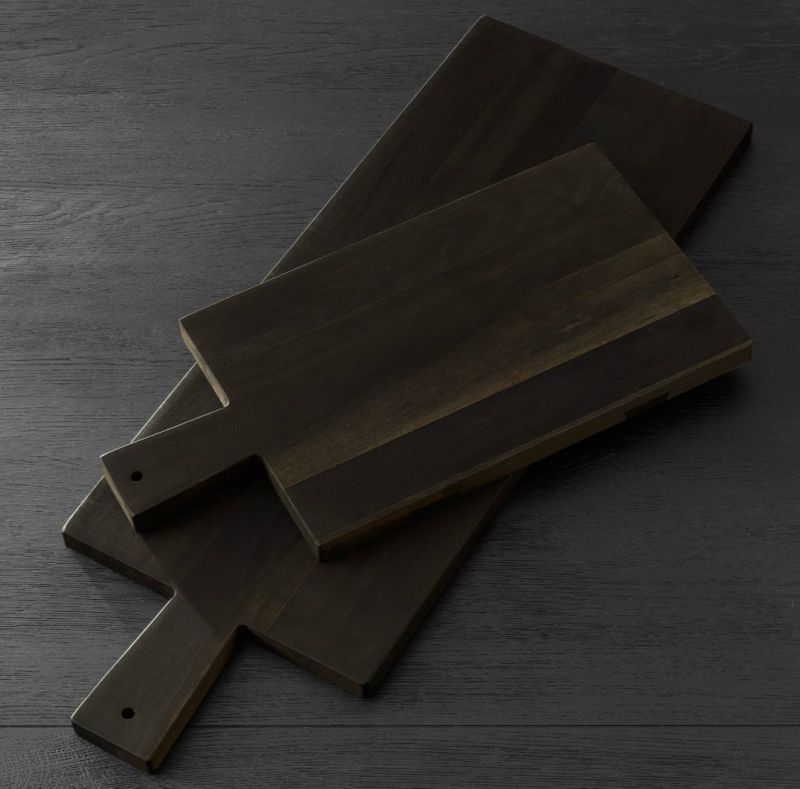Achieving a Gray Finish on Cherry Cabinets
A discussion of playing with white, black, and color ó and some suggestions about trying a different kind of wood, too. November 5, 2013
Question
I would like to achieve this look on cherry door and drawer fronts. Would this gray color be achieved by using black dye? I know gray is made with black and white color, Iím just not sure how to achieve white with dye.

Click here for higher quality, full size image
Forum Responses
(Finishing Forum)
From contributor M:
Those are probably imported factory boxes. The rail/stile joints, uneven finish, general blotchiness, and poor sanding are a dead giveaway. My guess is that they are probably finished with a black wiping stain. I don't see any indications of a more complicated finishing process.
With cherry you are going to have to defeat the red tones, without making it too dark. This would not be an ideal choice for the look you are after. If you had a client that absolutely wonít have it any other way, then it could be possible, but I think there are better woods. To get achieve this look I would start out with a lighter wood that is more neutral in color, bleaching as a last resort. You can get white colorants (mixol) but I would try to avoid this. What you define as "gray" could be any thousands of actual shades so it is up to you experiment.
From contributor J:
I think that what you see as gray is coming from the way the picture was taken, or a Photoshop touch-up. I bet those cabinets aren't gray at all.
From the original questioner:
Well it sounds like I need to stick to a traditional cherry type finish as originally planned since I already built the cabinet with cherry.
I'm open to other wood suggestions as I haven't ordered my fronts yet. I could probably get away with bleaching the face frame which will be covered by full overlay doors anyway. The more I think about it, the more I really like this look and would like to duplicate it due to its uniqueness.
From contributor S:
It may be store bought or it may be custom. Iím thinking custom due to poor reveals (uneven drawer width) and sealer sanding. The picture is of an open pore wood, cherry not so open. The finish is more than likely bleached with a tinted white base coat stain, unevenly sanded sealer, glaze - which highlights poor sealer sanding scratches and topcoat.
It can be done with a multi-color step process, starting with bleach. Start simple and try with a one-step color on sanded sample and see what you get. You may need to do a couple of color steps with lock in coats between including striking out/highlight steps in order to achieve the effect you desire. Again it can be done, just how windy the road your willing to travel is up to you. Good learning/technique exercise!
From contributor C:
The wood appears to be a mahogany.
From the original questioner:
Upon further research I have read about a homemade stain made by using 0000 steel wool soaked in vinegar for a few days. I'm going to give it a try on some test cherry and see what happens. I'm wondering if it even turns gray if the topcoat of the amber EV will ruin the color (or perhaps enhance it).
From contributor X:
I would try an open grain wood like white oak. Stain and shade it with white stain. Then seal and glaze with black glaze. The glaze will turn the stain gray and accent the grain to the black undertone.
From contributor F:
No, there is no such thing as a white dye but that does not mean you can't make a gray toner. A typical mix would be one part vinyl sealer to four parts lacquer thinner. Then add a small amount of white pigment or compatible white lacquer and black dye. The color would have to be adjusted with smaller amounts of red and yellow to get the right shade of gray. This is sprayed directly on the wood, sealed and a glaze is probably applied also to fill in the grain and the profiles. Keep in mind these types of toners can settle quickly so product agitation during spraying is recommended.
From contributor R:
You will need quartered cherry and even that won't have the definition in the picture. The picture looks almost like a quartered anigre with no figure. Rift ash or oak would work nicely. I find bleaching helps a ton with these colors, most of which are to match pre-dyed specialty veneers that come in all kind of wild colors. I would stay away from the white as much as possible or you will just end up with a muddy grey whitewash job. The trick to getting gray is complimentary colors. If you add the complement to any color you end up with gray. The trick is finding the true complement to the wood color. For cherry that will be some tone of very thin blue. If you bleach first to get the wood as light as possible you will introduce some yellow into the color and will need to explore the violet shades. Make the stain very thin and apply slowly until you get gray. Then you can seal and tone to get an exact color match. Do several samples and you will get the idea.
From contributor S:
Depending on how one is applied and/or treated a tinted white base color coat, let alone how thin the formulation is or what grit the white wood sanding ends up can all make an impact. Contributor R you are spot on regarding blue. Its use as a base color has been the trick a couple of times. Yet for gray it may need to be tempered with a brown, warm or cool, and some yellow may be lurking somewhere with the possibility of a red or as you suggest, violet so a green cast is avoided. Extending the palette here a bit, no?
To the original questioner: if you have these at your disposal and the time, go at it with samples exploring dyes, pigment wipes, glazes, toners and combinations therein all the while maintaining as much clarity and depth as possible. Layered thin color coats and washcoats may be key - or not. Through the process you will discover what works for you. Great fun and a learning experience.
From the original questioner:
Switching gears a little bit; what do you all think of this sort of finish below on a cherry cab? I was thinking that this type of coloring using a vinegar and steel wool mix, finished with multiple coats of EV would look quite sharp and unique.

Click here for higher quality, full size image
From contributor G:
You can get that color by thinning down a water-based white stain and adding black and green dye. You may have to bleach if you can't kill the red enough.
From contributor U:
Personally I find that the wonderful characteristics of cherry are totally lost. It is my experience that acetic acid/Fe stains make the wood look dirty. It also appears that your stain is a little too strong and that much of the figure is lost.
From the original questioner:
Well my vinegar plus steel wool experiment didn't exactly pan out like I had hoped. It just darkened the wood into a muddy black no matter how I diluted the mixture. Oh well - back to the drawing board. I'd really like to do this without having to spend a lot of cash experimenting. It sounds like I may have to go back to a more classic boring finish.
From contributor H:
You need a high tannic acid level wood for the vinegar/iron oxide chemical reaction finish to work. White oak turns a blue/black instantly. You can buy tannic acid to apply to the wood before the vinegar mix. I've found that the pores do not stain well with that mix. Either surface tension or something else causes the problem. I do love the look on my woodturnings though.
Editor's Note: Carter Products (website) has an extensive line of woodturning and woodworking products.

